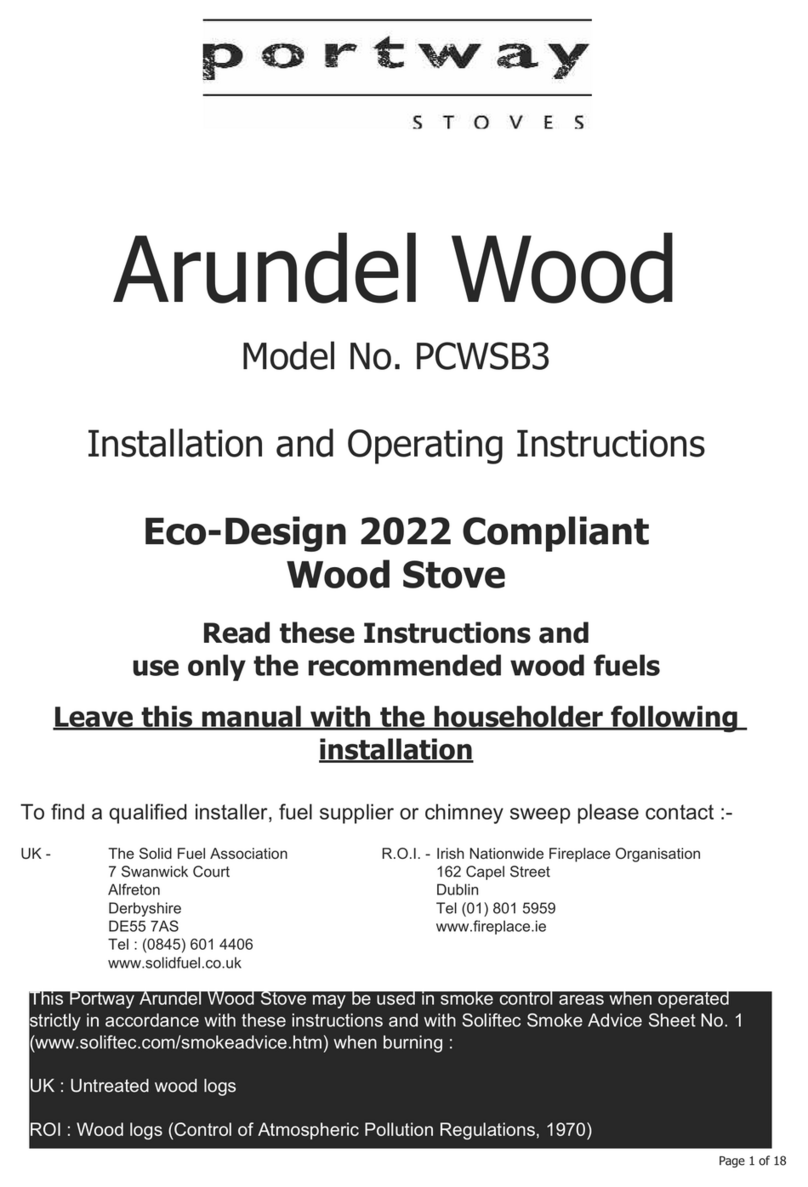
Section 2 - Stove Installation Requirements
2.1 WARNING - Installing a stove is a controlled service, the law requires that the
installation is completed by a qualified installer or that the building inspector is in
formed. Check with your local authority.
2.2 ASBESTOS - This Portway stove does not contain asbestos, but asbestos material
may be encountered during installation of the stove. If in doubt contact a suitably
qualified professional to deal with Asbestos or material suspected to be asbestos.
2.3 WEIGHT - Your stove is heavy 71.5kg Net (85kg packed) - take care when
moving it and ensure that the fireplace to which you are attempting to install it
can take the weight - consider the use of a load distribution plate.
2.4 FIREGUARD - This stove becomes extremely hot is use, therefore a fireguard
should be used if children, the elderly or infirm are present.
2.5 FIREPLACE - Stoves become extremely hot in use, therefore the fireplace to
which the stove is installed must be made from durable fireproof materials. Thin
stone slabs (less than 50mm) risk cracking unless cut into sections to allow for
expansion and backed by heat resistant concrete. Even beyond the safety
clearances stated items subjected to radiant heat from the stove can still become
extremely hot, therefore please take care when siting items such as fuel, paper
etc.
2.6 AIR SUPPLY - Your stove needs air to breathe and therefore perform correctly.
There must be a permanent fresh air supply into the space to which it is installed
equal to 550mm2 for each kW of output. This can often be provided by air leaking
around door frames etc. It is commonly accepted that this level of adventitious
ventilation alone may suffice for stoves of output less than 5kW but requirements
for additional ventilation should be considered. If an extractor fan is fitted in the
room, any interconnecting room or room in the vicinity can detrimentally affect
the performance of the stove so please check stove performance with these
extraction fans in operation. Where there are additional combustion appliances
within the property please ensure that the relevant requirements of Approved
Document J of the Building Regulations are complied with.
When air inlet grills are positioned to provide combustion air they must not be
liable to blockage. Regular checks should be made to ensure that any air inlet
grill is not obstructed. It is essential that the stove has adequate air supply for
combustion and ventilation. Apertures provided for this purpose shall not be
restricted.
2.7 REGULATIONS : All local regulations including those referring to National
and European standards need to be complied with when installing this appliance.
Refer to the current version of BS 8303, Code of Practise for installation of
domestic heating and cooking appliances burning mineral fuel. Refer to the
current version of BE EN 15287-1, Design, Installation and Commissioning of
Chimneys.The hearth should extend a minimum at least 300mm in front of the
stove (Portway recommend 400mm) and 150mm to each side. A minimum of
50mm clearance to non-combustible materials is required at each side of the
stove for access for servicing and maintenance. There must be no combustible
material positioned within 1000mm of the front of the stove. Page 5 of 17




























